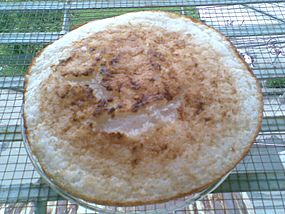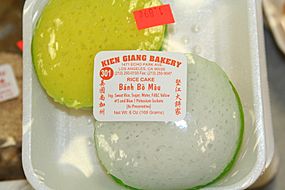Bánh bò facts for kids

Bánh bò hấp (steamed bánh bò)
|
|
| Type | Sponge cake |
|---|---|
| Course | Dessert |
| Place of origin | Vietnam |
| Region or state | Southeast Asia |
| Main ingredients | Rice flour, water, sugar, yeast, coconut milk |
| Similar dishes | Htanthi mont, Fa gao |
Bánh bò is a yummy, chewy sponge cake from Vietnam. It's made with rice flour, water, sugar, and yeast. Inside, it looks like a honeycomb because of many tiny air bubbles. This special look is called rễ tre in Vietnamese, which means "bamboo roots."
Most of the time, coconut milk is added to the batter. This gives the cake a nice coconut flavor and smell. Bánh bò came from Southern China. The Chinese version, called bái táng gāo, doesn't have coconut milk. People usually eat Bánh bò as a dessert. Sometimes, it's eaten with a meal too.
Contents
What Does "Bánh bò" Mean?
In the Vietnamese language, bánh means "cake." The word bò can mean two things: "cow" or "to crawl."
One idea is that the cake is named because it looks like a cow's udder. This means the name might have been shortened from bánh vú bò, which means "cow udder cake." Another popular story says bò refers to how the cake "crawls" or rises up to the edge of the bowl when it's steamed.
It's important not to confuse Bánh bò with bánh bó. Bánh bó is a different fruit cake found in Quảng Ngãi Province. The way you say "bò" (cow) and "bó" (pressed) is different in Vietnamese.
Types of Bánh bò Cakes
There are several kinds of bánh bò cakes. Each one is made a little differently:
Baked Bánh bò (Bánh bò nướng)
This type of bánh bò is cooked in an oven. It's usually off-white or yellowish inside. The outside turns golden because the coconut milk gets caramelized (turns sweet and brown). These cakes are often big, so you usually eat just a slice, not the whole cake. Bánh bò nướng is always eaten by itself.
Steamed Bánh bò (Bánh bò hấp)
Bánh bò hấp looks similar to the baked version. These cakes are often small and round. They can be white, green (from Pandanus amaryllifolius plant extract), or even pink or pale purple (from magenta plant extract).
There are a few ways to enjoy Bánh bò hấp:
- You can eat it alone, just like the baked version.
- It can be placed inside bánh tiêu (Chinese hollow doughnuts) and eaten together.
- People also enjoy them in a small dish with a sweet coconut milk sauce on top. This sauce often has tapioca starch to make it thick. Sometimes, a little bit of muối mè (sesame salt) or muối đậu phộng (peanut salt) is sprinkled on top.
Both the traditional baked and steamed bánh bò are popular in Vietnam. You can also find them in Asian grocery stores in countries like the United States and France, where many Vietnamese people live.
Milk Bánh bò (Bánh bò sữa)
This is a newer type of bánh bò that became popular in the mid-2000s. Instead of coconut milk, it uses condensed milk or milk powder. It's usually cooked in a small pan.
Coconut Bánh bò (Bánh bò dừa)
Bánh bò dừa is the newest type, appearing in the late 2000s. It's quite different from the others because its main ingredients are different. It uses wheat flour, chicken eggs, and baking soda, along with sweetened coconut. This cake often tastes chewier and can be crispy on the outside. Inside, it has sweetened coconut mixed with cooked mung bean.
The Indian steamed rice cake called idli has a similar texture to bánh bò, but idli is not sweet. However, bánh bò is quite similar to Vattayappam, which is a type of appam from Kerala, India.
See also
 In Spanish: Bánh bò para niños
In Spanish: Bánh bò para niños



